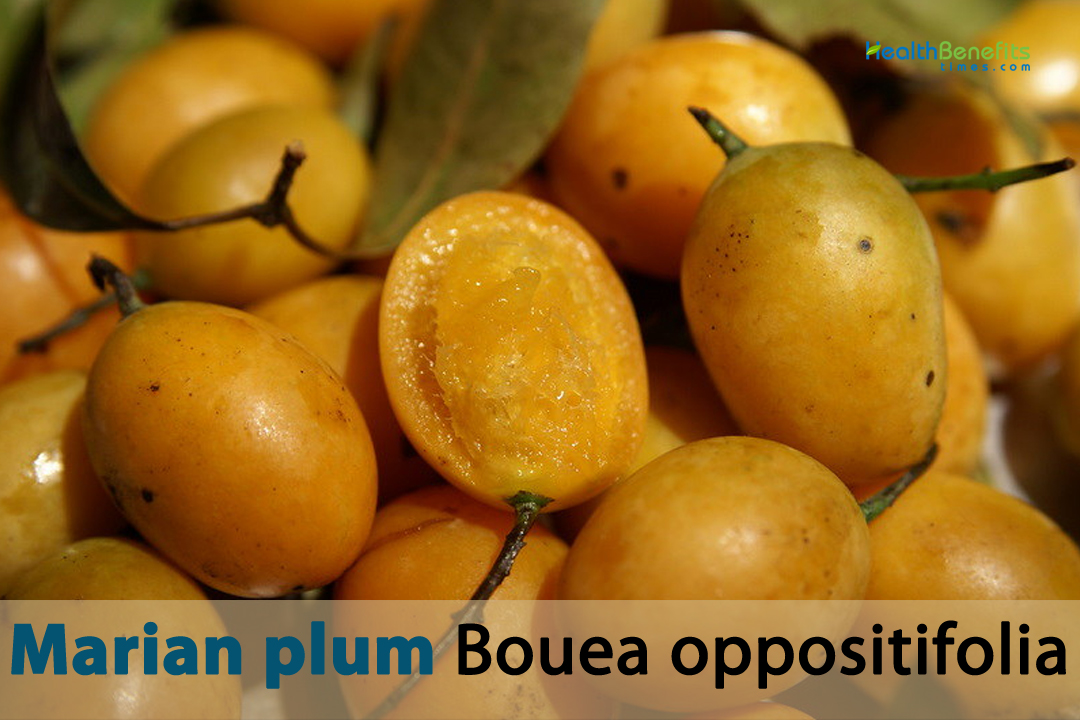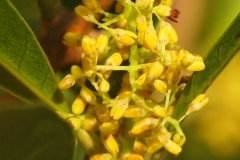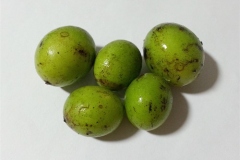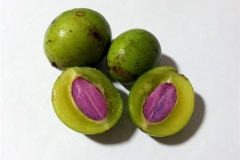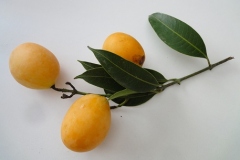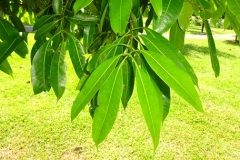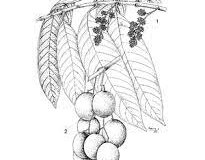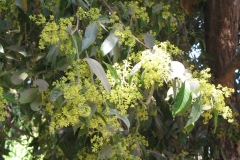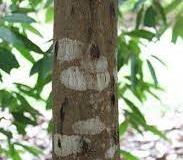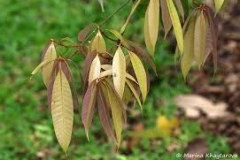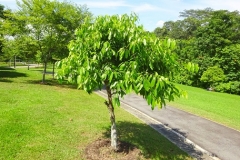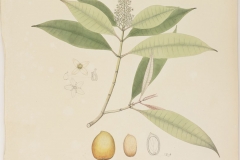In the early 1800s, the French scientist Adolphe-Théodore Brongniart came up with the name “Bouea” for the genus. It is named after Louis Eugène Bout, a French botanist and gardener who lived from 1814 to 1884 and was known for his work on the plants of Africa. The name “oppositifolia” comes from two Latin words: “oppositus” means “opposite” and “folium” means “leaf.” This name comes from the way the plant’s leaves are grouped on its stem. Each pair of leaves is at a right angle to the pair above and below it, giving the plant its name.
Marian Plum Facts
| Marian plum Quick Facts | |
|---|---|
| Name: | Marian plum |
| Scientific Name: | Bouea oppositifolia |
| Origin | Andaman Islands, Myanmar, Laos, Cambodia, Thailand to Vietnam and South China |
| Colors | Initially green turning to yellow, orange, or reddish-brown |
| Shapes | Typically ovoid or oblong in shape, about 2 to 4 centimeters in diameter, with a thin, smooth skin |
| Flesh colors | Orangey |
| Taste | Burst of sweetness with a mild tanginess |
| Health benefits | Digestive Health, Weight Management, Skin Health, Cardiovascular Health, Immune System Support, Bone Health, Eye Health, Liver Health, Wound Healing and Skin Care, Gastrointestinal Relief |
| Name | Marian plum |
|---|---|
| Scientific Name | Bouea oppositifolia |
| Native | Andaman Islands, Myanmar, Laos, Cambodia, Thailand to Vietnam and South China (Yunnan, Hainan), Indonesia (Sumatra, Java, Kalimantan) and Malaysia and other surrounding regions |
| Common Names | Burmese Plum, Marian Plum, Marian Tree, Plum-Mango, Maprang, Maprang Plum, Philippine Wild Mango, Wild Plum, Gandhara, Thai Mango, Gandaria Mango, Membangan Tunggal, Mangga Pulo, Gandarusa, Prangeh, Wani, Gandaria, Kundangan, Ma-praang, Bai Makok, Membangan, Maran Plum, Ramania, Kundang, Gourka, Plum Pangium |
| Name in Other Languages | Acehnese: Bue mude Arabic: Barqūq handiyy (بَرْقَوق هَنْدِيّ), Barqūq Maryān (برقوق ماريان) Assamese: Mekakhani, Mekhedi, Mehedi (মেহেদি), Jamun (জামুণ) Batak: Mani sali Balinese: Buah mau-mau Bengali: Bilati amra, Amṛā (আমড়া), Jômira (জমিরা), Barakhau plāma (বরখাউ প্লাম), Mehedi (মেহেদী), (Jam জাম), Māprāṅ Bicolano: Randa Bikol: Maluko Bodo: Jamun (जामुन) Borneo: Kedjauw Lepang, Tampusu, Asam Djanar, Bandjar, Kundang Rumania, Ramania Hutan, Ramania Pipit, Rengas, Tolok Burung, Umpas Buginese: Tua banua, Tua gogorau Burmese: Meriam, Ma-yai-daw, Mayae-daw, Meyo, Mahalu thi (မဟာလူသီး) Cebuano: Kundang Central Khmer: Kph m l t robang (ក្ផម៉លតរបង) Chinese: Yìndù lǐzi (印度李子), Yìndù méi (印度梅) Chittagonian: Kuwini Danish: Indisk blomme, Vild blomme, Indisk kirsebær Dimasa: Tungkam Dogri: Mehendi (मेहेन्दी), Jamun (जामुन) Dutch: Indiase pruim, Wilde pruim, Indische pruim, Antilliaanse pruim English: Marian plum, Plum Mango, Wild Mango, Indian plum, Indian berry, Hog plum, Wild plum, Jungle plum, Country gooseberry, Mariantree, Narrow-leaved Kundang Estonian: India ploom, Antillide ploom Filipino: Gandaria, Maran Plum, Membangan, Gandaras, Marang, Plum India, Duhat Finnish: Intianluumu, Metsäluumu, Intiankirsikka French: Prunier des Indes, Prunier sauvage, Prune de la Martinique, Abricot pays, Prune d’Antilles Garo: Rangatikka German: Indische Pflaume, Wilde Pflaume, Dschungel-Pflaume, Antillenpflaume, Indische Kirsche Gorontalo: Arayu, Kawayu Greek: Indikó damáskino (Ινδικό δαμάσκηνο), Marian plum (Μαριάν πλαμ) Gujarati: Mehendi nu shing (મેહેંદીનું શિંગ), Jambudi (જાંબુડી) Hausa: Gandul Hiligaynon: Mangga Pulo Hindi: Amṛā (अमड़ा), Jangali ber (जंगली बेर), Mehndi booty (मेहंदी बूटी), Marian plum (मरीन प्लम), Golak (गोलक), Jamun Phal (जामुन फल), Jambul (जंबुल) Hmar: Vawk-vawk Ibibio: Garat Igbo: Kongar Ilokano: Kundang Indonesia: Kaju-Rusun, Kunangan, Raman Burung, Raman Padi, Raman Utan, Reiden Daun; Gandaria, Raman, Uris, Urisan, Ramania Pipit, Umpas, Wani, Kundangan, Kedondong Italian: Prugna indiana, Susina selvatica, Prugna delle Antille, Susino delle Antille Japanese: Indo sumomo (インドスモモ), Indo no sumomo (インドのスモモ) Javanese: Garat, Gandhara, Mambal, Mehandal Kannada: Prangeh, Odu, Amādu (ಅಮಾದು), Sēvu (ಸೇವು), Hesaru menasu (ಹೆಸರು ಮೇಣಸು), Nāgapajaṁ (ನಾಗಪಜಂ) Kapampangan: Randa Karbi: Chokoi Kashmiri: Mehndi (مهندي), Zamb (زامب) Khasi: Ïaw Jyrmieh Khmer: Ko-khwaai, Chor Kampil (ចារតំបិល្ល) Kokborok: Chakui Konkani: Randa, Māvãḍaṇṇa, Mehendi (मेहेंदी), Jambul (जांबुळ) Korean: Indo jadu (인도 자두) Kurukh: Jamun Lao: Puan, Pha lat indō (ພະລາດອີນໂດ) Latvian: Indijas plūme Lithuanian: Indinė slyva, Antilų slyva Maasai: Plum Pangium Madurese: Buah kiray Magahi: Kuni Makassarese: Makahia Maithili: Mehedi (মেহেদি), Jamun (জামুন) Malay: Buah Membangan, Mangis, Ceremai, Kedondong hutan, Gemior, Kundang Daun Kechil, Rumenia, Rumia Malayalam: Puan, Membalam, Kedundong, Mullilam, Aṭappaḻaṁ (ആടപ്പഴം), Kattukka (കട്ടുക്ക), Nāgapazham (നാഗപ്പഴം), Perintila (പേരിന്തിളവ), Asam djanar, Bandjar, Kedjauw lepang, Kundang rumania, Ramania hutan, Ramania pipit, Rengas, Tampusu, Tolok burung, Umpas Malaysia: Perus, Gemia, Gemis, Kemunia, Kundang, Kundang Daun Kecil, Kundang Rumenia, Kundang Siam, Merapoh Rumenia, Poko Rummiyah, Rambainyia, Ramunia, Rembunia, Remnia, Romaniah, Rumboi-Nigor, Rumenia, Rumenia Betul, Rumia, Rumiah, Rumiang Manipuri: Heikru (ꯑꯔꯨꯑꯣ), Jam Kobi (ꯂꯦꯟ ꯊꯣꯏꯣ) Minahasan: Amawoka Minangkabau: Gandaria Mishing: Mehedi (মেহেদি) Mizo: Rangatiki Marathi: Randa, Mehndi (महंग), Jambhul (जांभुळ) Mundari: Jamun (জামন) Nepali: Kukhura sali, Mewah, Mehendi ko phal (मेहेन्दीको फल) Norwegian: Indisk plomme, Vill plomme, Indisk kirsebær Odia: Rata, Māṇḍāmāṇḍā, Nāga jambu (ନାଗ ଜମ୍ବୁ), Kala jambu (କଳ ଜମ୍ବୁ) Pangasinan: Kundol Pampangan: Randa Portuguese: Ameixa-da-Índia, Ameixa-da-roça, Ameixa-do-mato, Amelão, Jocote, Taperebá-do-Pará Punjabi: Karau, Mehndī dā guṭlā (ਮਹਿੰਦੀ ਦਾ ਗੁੱਟਲਾ), Jambul (ਜਾਂਬੁਲ) Russian: Indiyskaya sliva (Индийская слива), Dikaya sliva (Дикая слива), Antil’skaya sliva (Антильская слива), Mapring (Мапринг), Marianskaia sliva (Марианская слива) Santhali: Jahar (ᱢᱟᱨᱟ) Sindhi: Kundong, Mehndi jo pan (ميهنڊي جو پڻ) Sinhalese: Gandarusa, Galdari, Indiyanu polondā (ඉන්දියානු පොලොන්ඩා) Spanish: Ciruela del monte, Ciruela cimarrona, Jobo de la India, Ciruela de la India Sundanese: Komu, Mambalo Swahili: Plum ya India, Tufaa la India Swedish: Indisk plommon, Vildplommon, Indisk körsbär Tamil: Mavilangai, Paaralam, Mangga Pulo, Atthi pazham (அத்தி பழம்), Kattukku (கட்டுக்கு), Karuppuṇṭi (கருப்பூண்டி), Nākappaḻam (நாகப்பழம்) Tangkhul: Heihei Tausug: Tugbung Telugu: Kwini, Mekudu, Āḍapaṇḍu (ఆడపండు), Rēgu rēgu (రేగు రేగు), Nērēḍu paṇḍu (నేరేడు పండు), Nāgapajaṁ (నాగపజం) Tetum: Buah kudu Thai: Ma-praang, Bai Makok, Ma Prang, Ma Prang Wan, Makok farang, Makok puang, Makok (มะกอก), Ma-phrao Indiya (มะพร้าวอินเดีย), Mai ma praang (ไม้มะปราง ), Ma pring (มะปริง) Turkish: Hint eriği, Hint eriği ağacı Tumbuka: Kedundong Vietnamese: Bantang, Tangai, Trái cay mận, Mận nước, Mận Ấn Độ , Mận Tây Indies Visayan: Randa Waray: Komu |
| Plant Growth Habit | Erect, medium-sized, evergreen, perennial tree |
| Growing Climates | Lowland forest, peat forest, kerangas, and sometimes on limestone |
| Soil | Thrive in well-draining soil with a pH ranging from slightly acidic to neutral (pH 5.5 to 7.0). The soil should be rich in organic matter and nutrients |
| Plant Size | Up to 32 m high and with a trunk diameter of 75 cm |
| Root | Plant grows a main root called the taproot. The taproot grows straight down into the dirt; giving the young tree stability |
| Stem | Straight, woody stem that grows up from the ground and is in the middle of the plant. It is the main support for the tree as a whole. Bark covers the trunk and works as a barrier against pests, diseases, and the environment |
| Bark | Grey-green light brown to purple-brown fissured bark |
| Leaf | Leaves are opposite, coriaceous, elliptic to elliptic-oblong, lanceolate to oblanceolate, 2–15 cm by 1–5 cm, glabrous, acute to cuneate base and acuminate apex, nerves usually 8–14 (−26) pairs, light violet brown when young and dark green older, (Plate 4) petiole 0.5–2 cm |
| Flowering season | Around February to April |
| Flower | Inflorescence in axillary panicles, 2.5–6 cm long. Flowers white to pale yellow, with broadly ovate calyx lobes, oblong-obovate-oblong petals, stamens 0.6–1 mm with apiculate anthers |
| Fruit Shape & Size | Fruit is typically ovoid or oblong in shape, about 2 to 4 centimeters in diameter, with a thin, smooth skin with sourish juicy orangey flesh and one seed with violet purple cotyledons |
| Fruit Color | Initially green turning to yellow, orange, or reddish-brown, depending on the variety |
| Flesh | Sourish juicy orangey flesh |
| Seed | Relatively large and have an oval or ellipsoid shape. They are typically around 2 to 3 centimeters (0.8 to 1.2 inches) in length |
| Flavor/Aroma | Rich and enticing fragrance with hints of floral notes, reminiscent of a lush, sunny orchard |
| Taste | Burst of sweetness with a mild tanginess |
| Plant Parts Used | Leaves, bark, fruits, seed, roots |
| Propagation | By seeds, stem cuttings, Air layering, Grafting |
| Lifespan | Range from 20 to 30 years |
| Season | May to August, with peak fruit production occurring during June and July |
| Varieties |
|
| Major Nutrition |
|
| Available Forms |
|
| Health benefits |
|
Plant Description
The Marian plum is a medium-sized, upright, evergreen, perennial tree that grows up to 32 m tall and has a trunk that is 75 cm in width. The plant grows in wetland forests, peat forests, kerangas, and sometimes on limestone. The plant does best in dirt that drains well and has a pH between 5.5 and 7.0, which is slightly acidic to neutral. The earth should have a lot of living things and nutrients in it. The best types of dirt are sandy loam or loamy.
Appropriate growing environment of Marian plum
Marian plum thrives in tropical and subtropical climates, and it requires specific growing conditions to flourish. Here are some key factors for creating an appropriate growing environment for Marian plum:
- Climate: Marian plum trees like it when it is hot and humid in the tropics. They do well in places where the weather is always warm, with average annual temperatures between 68°F (20°C) and 86°F (30°C). Frost can hurt the tree, so it’s important to keep it away from places where it’s likely to freeze.
- Sunlight: For these trees to grow and make fruit, they need a lot of sunshine. They should be placed in a spot where they can get full sun for at least 6 to 8 hours a day.
- Soil: Marian plum trees do best in soil that drains well and has a pH between 5.5 and 7.0, which is slightly acidic to neutral. The earth should have a lot of living things and nutrients in it. The best types of dirt are sandy loam or loamy.
- Water: It is important to water the tree enough and consistently, especially when it is young and growing. But once the tree is established, it can handle a little bit of dry. This makes it a good choice for places where rain comes in cycles.
- Air Circulation: Fungus diseases can only be stopped if there is good air movement. Don’t put Marian plum trees in places with poor air flow, like low-lying areas or places with a lot of other plants.
- Space: Marian plum trees can get quite big, so they need room to spread out. Each tree should be planted at least 10 to 15 feet (3 to 4.5 meters) from other trees or buildings.
- Pruning: Regular pruning helps the tree keep its shape, improves air flow, and pushes it to make more fruit. Cut off stems that are dead or sick and thin out growth that is too dense.
- Fertilization: Regular fertilization is good for Marian plum trees. Use a fertilizer that has a good mix of nitrogen, phosphorus, potassium, and minerals. Fertilizer should be used in the spring and again after the fruit has been picked.
- Pests and Diseases: Keep an eye out for pests and diseases like fruit flies, aphids, scale insects, and white mildew that can harm Marian plum trees. If you need to, use the right ways to get rid of pests.
- Pollination: Some kinds of Marian plums can pollinate themselves, while others do better when they pollinate each other. If you want lots of fruit, you might want to put a few different kinds of trees close to each other.
Roots
At first, the plant grows a main root called the taproot. The taproot grows straight down into the dirt; giving the young tree stability and helping it stay put. In some cases, the taproot can keep growing and become the tree’s main storage system. When the Marian plum tree gets older, the taproot may send out many side roots. From the taproot, these side roots grow horizontally and branch out in different directions, making a network of root branches. Lateral roots are very important for getting water and food from the dirt.
Root hairs are tiny structures that look like tiny hairs and are found on the lateral roots. These root hairs make the root system’s surface area much bigger, which lets the tree take in more water and nutrients from the earth around it. At the ends of the side roots, there are many small roots that look like threads. These are called feeder roots. Most of the water and nutrients that plants get from the dirt are taken up by these. They have a lot of surface area so they can get as many nutrients as possible.
Stem
The main trunk of a Marian plum is the straight, woody stem that grows up from the ground and is in the middle of the plant. It is the main support for the tree as a whole. Bark covers the trunk and works as a barrier against pests, diseases, and the environment. The tree’s main trunk grows many branches that spread out horizontally and make up the tree’s top. Depending on how the tree grows and how old it is, the number, size, and order of its branches change. Most young trees have fewer branches than older trees, which have a well-developed system of limbs.
The stem is made up of nodes and the spaces between them. Nodes are the places on a plant where leaves, buds, and branches grow out. Internodes are the gaps between two nodes that are close to each other. Both nodes and internodes are important for the growth and development of the plant. Vascular bundles are special cells in the stem that move water, nutrients, and sugars around the plant. Xylem cells move water and minerals from the roots to the leaves, while phloem cells move sugars and other organic chemicals from the leaves to other parts of the plant. Lenticels are small, raised, porous spots on the surface of the stem that let gases move between the stem’s cells and the air around it. They are important for gas exchange, especially in woody roots where the outer bark could make it harder for gas to move.
Bark
The bark is what protects the tree’s base and branches from the outside world. The periderm is the layer of bark that is on the outside. It is made up of cork cells that are dead when they are fully grown. These cork cells are filled with suberin, which is a waxy material that makes them waterproof and resistant to decay. The bark on the outside protects the tree from physical damage, pathogens, and weather stress. The cork cambium or phellogen is a layer of rapidly dividing cells just under the bark. The cork cambium makes new cork cells on the outside of the cork and phelloderm cells on the inside. Between the cork cambium and the secondary phloem is a thin layer of live cells called the phelloderm.
Below the cork cambium and phelloderm is the secondary phloem, which moves the sugars made by photosynthesis from the leaves to the rest of the tree. The secondary phloem is made up of special cells called sieve elements and partner cells. These cells work together to help move nutrients. The vascular cambium is a layer of rapidly dividing cells that is further inside the bark. The vascular cambium makes new cells on both the inside (secondary xylem) and the outside (secondary phloem) of the plant. This process of constant growth is what makes it possible for the tree to get wider over time.
Leaves
The leaves are staggered along the stems, which mean that they come out one at a time on different sides of the stem and not right next to each other. This arrangement makes sure that each leaf gets enough light and room to grow. Leaves are simple, which means they only have one leaf blade and are not broken up into lobes. The leaf blade is usually oblong, elliptic, or lanceolate in shape, with a sharp tip (acuminate) and a tapered base. The leaves can be small, medium, or big, and their lengths can range from 4 to 12 inches (10 to 30 centimetres).
The veins in leaves are pinnate, which means that there is one main vein that runs down the middle of the leaf blade and smaller veins that branch off from it. The arrangement of veins helps water and food get to all parts of the leaf and gives the leaf structure. Most leaf margins are smooth, which means they don’t have any big teeth or serrations. On the edge of the leaf, however, there may be small bumps. The leaves feel like leather, which makes them less likely to lose water through evaporation and more resistant to damage from the environment. The top of the leaves is shiny and dark green, while the bottom is light green. This helps the plant absorb as much light as possible during photosynthesis.
The thin stalk that holds each leaf to the stem is called the petiole. The length of the petiole can change, but it gives the leaf the ability to face the sun in the best way. The pointy end or tip of a leaf is called its apex. The Marian plum’s tip is usually acuminate, which means that it tapers to a long, thin point. The point where the stalk meets the leaf blade is the base of the leaf. The base of a Marian plum is usually tapered, which means it gets smaller and smaller as it gets closer to the point of connection.
Flowers
Most flowers grow in groups, which are called inflorescences. The type of flowering structure is a panicle, which is a branching group of flowers connected to the main stem, or peduncle. Most of the time, the flowers are small and made up of five parts. Each flower has five different parts: five petals, five sepals, and five stamens. Most of the time, the flowers are white or cream, and they have a simple, round shape.
The petals are the green parts of the flower that are on the outside. They cover the bud before it opens and give the petals something to hold on to. The petals are the colorful, showy parts of the flower that draw pollinators like bees, butterflies, and other insects. Most petals are white or cream in color, and they are grouped in a circle. The stamens are the parts of a flower that make male offspring. There is a thread and an anther on each stamen. The pollen grains are made in the anther. The pistil is the female part of the flower that makes seeds. It is in the middle of the flower and is made up of the stigma, the style, and the ovary.
The stigma is the part of the pistil that is at the top. It is usually sticky or fluffy. Its job is to get pollen grains when a plant is being pollinated. The style is the thin, tube-like part that ties the stigma to the ovary. It gives pollen a way to get from the stigma to the egg. The ovary is the base of the pistil that is bigger and holds one or more ovules. The fruit grows from the ovary after it has been pollinated and fertilized. Some flowers make nectar, which is a sweet liquid that helps insects do their job. Insects are drawn to nectar, which helps them spread pollen.
Fruit
Drupes are plump fruits with a single seed that is protected by a hard stone or pit. They are usually oval or elliptical in shape, and their lengths can range from 3 to 5 centimetres (1.2 to 2 inches). The skin or exocarp is the part of a fruit that is on the outside. When the Marian plum is ready to eat, the thin, smooth exocarp can be green, yellow, or orange. The mesocarp is the part of the fruit that is juicy and can be eaten. It is found under the exocarp. The Marian plum’s mesocarp is sweet, smells good, and tastes great. It has the sugars and flavors that make people want to eat the food.
The endocarp is a hard, woody shell that covers the single seed in the middle of the fruit. The endocarp keeps the seed from getting hurt and gives the fruit its shape. As the fruit ripens, it changes color. When the fruit is young, it is green. As it ripens, it turns yellow, orange, or reddish-brown, based on the type. The color of the fruit shows whether or not it is ready to be eaten. The Marian plum fruits taste sweet, sour, and slightly acidic. They can be eaten fresh as a snack or used in a variety of ways in cooking. The fruit smells good and makes you want to try it. When the fruit is ready, it is juicy and its meat has a lot of water. The drink tastes good and is good for you.
Seeds
The seeds are pretty big and oval or globular in shape. Depending on the size of the fruit, they are usually between 2 and 3 centimetres (0.8 and 1.2 inches) long. The seed’s top layer, called the seed coat or testa, is there to protect it. The seed coat is tough and protects the delicate parts inside the seed by making a shield. Endosperm is found inside the seed coat. Endosperm is a tissue that stores food for the baby as it grows. It has a lot of starches, proteins, and oils, which give the plant energy as it grows.
The young plant that grows from the seed is called the embryo. It is made up of the epicotyl, which will grow into the stem and leaves, and the radicle, which will grow into the root system. The endosperm feeds the egg until the seedling can make its own food through photosynthesis.
Varieties of Marian plum
The Marian plum has several varieties that vary in characteristics such as fruit size, color, taste, and overall tree growth. Some of the common varieties of Marian plum include:
- Manila Plum: This type is known for having sweet fruits that are big. When ripe, the fruits have a yellow-orange color and an oval or elliptical form. One of the most famous kinds of fruit in the Philippines is the Manila Plum.
- Kari Plum: The Kari Plum is a popular type in Indonesia and Malaysia. Its fruits, which are usually smaller than those of the Manila Plum, are prized for being juicy and sweet. When the fruit is ready, the skin can be green or yellow.
- Kradum Plum: This type comes from Thailand and is highly valued for its great taste and pleasant smell. The fruits are about the size of a fist and have a yellow or orange skin that tastes sweet and a little sour.
- Gandaria: This type is often found in Indonesia, where it is also known as Binjai. The fruits are on the small side, and the meat is juicy, sweet, and just a little bit sour. When it’s ready, the skin can be green, yellow, or red.
- Chocanan Plum: This type is well-liked in the Philippines because its fruits are sweet and tasty. When it’s ready, the Chocanan Plum has a reddish-brown skin that stands out.
- Chumporn Plum: This type, which comes from Thailand, grows small to medium-sized fruits with a yellowish-green skin. The meat tastes sweet and cool.
- Nangka Plum: This type is from Malaysia, and its name comes from the fact that it tastes like jackfruit (nangka). The fruits are about the size of a fist, and the meat has a nice mix of sweet and slightly sour tastes.
- Seedless Marian Plum: Some cultivated types are chosen because they don’t have seeds. This makes them easier to eat because you don’t have to deal with the hard seed.
Health benefits of Marian plum
Marian plum offers several potential health benefits, as it is a rich source of various nutrients and bioactive compounds. Here are some of the health benefits of Marian plum in detail:
1. Rich in Nutrients
The Marian plum is a good source of vitamins and minerals that your body needs. It has vitamins A, C, and E in it. Vitamins A, C, and E are antioxidants that help protect the body from damage caused by free radicals. The immune system, skin, and eyes are also helped by these vitamins. Minerals like potassium, calcium, and magnesium, which are important for heart health, bone health, and muscle function, are also found in the fruit.
2. Antioxidant Properties
There are natural antioxidants in the plant, like polyphenols, flavonoids, and carotenoids that help the body get rid of harmful free radicals. These antioxidants are very important for reducing oxidative stress and inflammation, which could lower the chance of chronic diseases like heart disease, cancer, and neurodegenerative disorders.
3. Digestive Health
The Marian plum has a lot of fiber, which helps your body digest food and keeps you from getting constipated. Fiber helps you have regular bowel movements, keep your gut bacteria healthy, and may lower your risk of GI problems like irritable bowel syndrome (IBS) and colorectal cancer.
4. Hydration
The fruit has a lot of water in it, which makes it a great choice for staying hydrated. Staying well-hydrated is important for a number of body processes, such as regulating temperature, transporting nutrients, and overall health.
5. Potential Anti-Inflammatory Properties
Some studies show that polyphenols and flavonoids, which are found in the Marian plum, may help reduce inflammation. If you eat the fruit regularly, it may help reduce inflammation and conditions like gout and some inflammatory skin conditions that are linked to it.
6. Weight Management
As a fruit with few calories and lots of nutrients, the Marian plum can be a good part of a plan to lose weight. The fiber level can make you feel full, making it less likely that you’ll eat too much and helping you loses weight.
7. Skin Health
Marian plums have vitamin C and other antioxidants that can help keep your skin healthy by boosting collagen production and keeping it from UV rays and pollution. If you eat the fruit, it might help you look younger and improve the health of your skin generally.
8. Immune System Support
Vitamin C, which is found in Marian plum, is known to help the nervous system. Vitamin C helps the body make and use more white blood cells, which are very important for fighting off infections and diseases. When eaten regularly, Marian plums may help improve the immune system and make common illnesses like colds and flu less severe and last less long.
9. Bone Health
Minerals like calcium, magnesium, and phosphorus, which are found in the fruit, are important for strong, healthy bones. Getting enough of these minerals may help avoid bone diseases like osteoporosis and keep bones strong and dense, especially as people get older.
10. Eye Health
The Marian plum has a lot of vitamin A and other pigments that are good for eye health. These chemicals are important for good vision, especially when there isn’t much light. They may also help lower the risk of age-related macular degeneration and cataracts.
11. Anti-Diabetic Potential
Some studies show that the Marian plum may help people with diabetes. Research shows that certain chemicals in the fruit could help lower blood sugar levels and make the body more sensitive to insulin. This could be helpful for people who have diabetes or are at risk of getting it. But more study needs to be done to fully understand how it affects how diabetes is managed.
12. Antimicrobial Properties
The fruit has some antimicrobial properties, which may be because it contains bioactive substances. These qualities may stop some bacteria and fungi from growing, which could help keep your mouth healthy and stop infections.
13. Anti-Cancer Properties
Even though research is still in its early stages, some studies have shown that products from the Marian plum’s leaves and fruit may help fight cancer. Cancer cells could grow and spread less if there are certain substances in the body that have antioxidant and anti-inflammatory properties. But more study is needed to figure out the exact mechanisms and how they might be used to treat cancer.
14. Liver Health
In traditional medicine, the Marian plum is used to treat problems with the liver. Antioxidant chemicals in the fruit might protect the liver from oxidative stress and help it work better. But it’s important to remember that there isn’t a lot of scientific proof in this area, and more research is needed to prove these claims.
15. Cardiovascular Benefits
Marian plum may be good for the health of the heart and blood vessels in other ways besides lowering blood pressure. Some studies show that the bioactive compounds in the fruit could help improve lipid profiles by lowering LDL cholesterol (“bad” cholesterol) and raising HDL cholesterol (“good” cholesterol). This result may make it less likely that you will get atherosclerosis or heart disease.
16. Anti-Aging Properties
Antioxidants like vitamin C and other polyphenols found in Marian plums help fight oxidative stress and free radicals that can speed up the aging process. If you eat the fruit regularly, it may help keep your skin looking young and prevent the start of age-related symptoms, giving you more energy overall.
17. Potential Anti-Hypertensive Effects
In some countries, the Marian plum has been used for a long time to treat high blood pressure. Some studies have shown that some compounds in the fruit may have vasodilatory benefits. This means that they can help open up the blood vessels, which could lower blood pressure.
18. Wound Healing and Skin Care
People also use the leaves of the Marian plum tree because they may have healing qualities. Wounds are sometimes treated with crushed leaves to help them heal and reduce swelling. The leaves can also be used in skin care products because they are soothing and refreshing.
19. Rich in Phytochemicals
There are many different phytochemicals in Marian plum, such as tannins, saponins, and terpenoids. These bioactive substances do different things in the body and may add to the health benefits of the fruit as a whole.
20. Gastrointestinal Relief
Traditional medicine has used the Marian plum to treat stomach problems like diarrhea and sickness. The fruit may help firm up loose stools and reduce inflammation in the digestive system because of its astringent properties.
21. Source of Energy
Because it has natural sugars, the Marian plum is a great way to get quick energy. As a snack or part of a meal, eating the fruit can give you a natural energy boost. This makes it a good choice for sports and other people who do physical activities.
22. Stress Reduction
Some personal experiences suggest that eating Marian plums may calm the body and mind. Even though it hasn’t been scientifically proven, the presence of certain compounds that might have relaxing effects could help lower stress and anxiety.
Culinary uses of Marian plum
Here are more detailed culinary uses of Marian plum (Java plum or Indian blackberry):
- Fresh Consumption: If you eat a fresh Marian plum, it tastes great. To eat it, you need to wash the fruit, cut it in half to get to the juicy inside, and take out the seed. You can eat the juicy fruit on its own or add it to fruit salads to make them sweeter and tastier.
- Jams, Jellies, and Preserves: The Marian plum is a great fruit for making jams, jellies, and preserves because it has a lot of pectin in it. Cooking the fruit with sugar and sometimes lemon juice makes a spreadable preserve that can be used on toast, biscuits, or as a filling for cakes and desserts.
- Chutneys: Marian plum chutney is a famous sauce in Indian food that goes well with many different dishes. To make it, you cook the fruit with ginger, garlic, chili, vinegar, or tamarind. This makes chutney that is spicy and full of flavor. It goes well with savory foods like samosas, pakoras, and grilled meats.
- Beverages: Marian plums can be used to make drinks that are cool and tasty. You can make a tasty juice or drink by blending the fruit with water or milk. You can also add it to fruit punches for a unique twist or puree it to make a thick, delicious fruit nectar.
- Desserts: Marian plum is a great addition to a lot of different kinds of sweets. You can make pies, tarts, and crumbles with the food. Use the raw fruit or its puree to add a natural sweetness to custards, puddings, or panna cotta.
- Ice Creams and Sorbets: Marian plums have sweet, juicy meat that works well in ice creams and sorbets. Blend the Marian plum with sugar, cream, or a vegan alternative like coconut milk to make a fruit-based ice cream or sorbet.
- Pickles: In some places, pickles are made with young or almost-ripe Marian plums. Fruit is soaked in a brine solution with spices, which makes pickles that are sour and slightly spicy and make a great side dish.
- Sauces and Syrups: When Marian plums are cooked down, they can be turned into sauces or syrups that can be used to top pancakes, waffles, or ice cream. The sauce can also be used to add a fruity glaze to roasted foods.
- Dried Marian Plum (Prunes): Some countries dry the fruit to make prunes, which are what most people call dried plums. Prunes are a healthy and tasty food because they are full of natural sugars and fiber.
- Cakes and Pastries: The Marian plum can be used to add a delicious fruity flavor to cakes, muffins, and other baked goods. Add chopped or pureed fruit to the batter, or use it as a filling for stuffed cakes.
- Fruit Leathers: By mashing up a Marian plum and letting it dry in sheets, you can make homemade fruit leathers, which are a healthy snack that you can take with you.
- Curries and Stews: In some traditional recipes, especially those from Southeast Asia, Marian plum is added to curries and stews. It gives the savory meals a tangy taste and goes well with the other flavors.
- Fruit Salsas: Make a tasty fruit salsa by mixing chopped Marian plums with other fruits like mango, pineapple, or bell peppers, as well as lime juice, parsley, and chili. This colorful and spicy salsa goes well with grilled meats, fish, or tortilla chips.
- Fruit Chutneys: Marian plum can also be used to make fruit chutneys instead of the usual chutneys. Cook the fruit with sugar, spices, and vinegar or lemon juice until it thickens into a chunky, sweet-and-sour sauce. This versatile condiment goes well with cheese platters, cold cuts, and roasted veggies.
- Stuffed Marian Plum: Core the Marian plum and put a mix of nuts, dried fruits, and honey in the hole. The stuffed fruits should be baked or grilled until they are soft and the filling is browned. This makes a beautiful and tasty dessert.
- Marian Plum Compote: To make a Marian plum stew, simmer the fruit with sugar, water, and spices like cinnamon or cardamom. The compote you make can be used to top pancakes, cereal, or yogurt, either warm or cold.
- Marian Plum Chutney BBQ Sauce: Mix Marian plum chutney with tomato paste, brown sugar, vinegar, and a dash of Worcestershire sauce to make a spicy BBQ sauce. Use this sauce to add flavor and a little bit of heat to grilled or roasted foods.
- Marian Plum Tarts and Galettes: Use pieces or halves of Marian plums to top a tart or galette made with butter. As the fruit bakes, it turns golden brown, making a treat that is both pretty and tasty.
- Marian Plum Marinade: Make a tasty marinade for chicken, pork, or tofu by blending Marian plums with garlic, ginger, soy sauce, and some oil. For a tasty and tender result, let the protein marinate for a few hours before cooking or roasting it.
- Marian Plum Salsa Verde: Make a unique salsa verde by mixing chopped Marian plum with fresh herbs like cilantro, mint, and parsley, as well as garlic, lime juice, and olive oil. This sauce goes well with fish, shrimp, or veggies that have been grilled.
- Marian Plum Ketchup: Use Marian plum juice, tomatoes, onions, vinegar, and spices to make your own ketchup. This sweet and tangy ketchup can be used to dip fries, chicken pieces, or burgers.
- Marian Plum Pie Filling: To make a tasty pie filling, cook Marian plum slices with sugar, cornstarch, and spices. Make a tasty treat like Marian plum pies, turnovers, or hand pies with this mix.
- Marian Plum Syrup: To make a thick and tasty fruit sauce, boil Marian plums with sugar and water. For a tasty breakfast treat, drizzle the sauce over pancakes, waffles, or French toast.
- Marian Plum Salad Dressing: Make a fruity and tangy salad sauce by mixing Marian plum with olive oil, vinegar, honey, and Dijon mustard. It makes a nice salad when mixed with mixed veggies, goat cheese, and toasted nuts.
- Marian Plum Lassi: In Indian cooking, you can make a cool lassi by mixing Marian plums with yogurt, sugar, and a pinch of cardamom. This cool, smooth drink is a great way to beat the heat.
Different Uses of Marian plum
Marian plum is a tropical fruit native to India and Southeast Asia. It is not only consumed fresh but also used in various culinary and medicinal applications due to its nutritional and medicinal properties. Here are some different uses of Marian plum:
- Medicinal Tea: Herbal tea made from the leaves of the Marian plum tree is thought to help digestion and improve general health.
- Beauty and Skincare: Because it is an antioxidant, the extract of the Marian plum is sometimes used in skin care items. It is thought to help the face stay healthy and keep its natural glow.
- Religious and Ritual Use: In some countries, the Marian plum tree is religiously important and is used in different ceremonies and rituals.
- Culinary Flavoring: The Marian plum can be eaten as a whole fruit, or it can be dried and ground into a powder that is used as a flavoring in some recipes, especially Indian food.
- Medicinal Supplements: Some health stores sell Marian plum remedies, like capsules and powders, because they are good for the digestive system and the body as a whole.
- Insect Repellent: The Marian plum tree has chemicals in its leaves and fruit that naturally keep insects away. Sometimes, crushed leaves are used to keep insects away.
- Fiber Source: Marian plums have a lot of fiber, which helps with digestion and makes you feel full. This makes them a good addition to diets that help you lose weight.
- Natural Mouth Freshener: Some people use dried Marian plum slices as a natural way to clean their mouths after eating.
- Wood Polish: The oil from Marian plum seeds can be used to clean wood in a natural way.
- Repellent for Storing Clothes: The dried leaves of the Marian plum are used to keep bugs and moths away from clothes and fabrics that are kept.
- Feeding Livestock: In some places, the leaves and seeds of the Marian plum are used to feed animals.
- Religious Offerings: In some countries, the Marian plum is a holy fruit that is used in religious ceremonies and celebrations.
- Beverage Fermentation: In some ancient ways of making alcoholic drinks, the Marian plum is used in the fermentation process.
Side effects of Marian plum
While Marian plum is generally safe for consumption and has several health benefits, excessive intake or use of certain parts of the fruit may lead to some side effects and adverse reactions. Here are the detailed side effects of Marian plum:
- Diarrhea and Abdominal Discomfort: If you eat a lot of the Marian plum or its products, you might get diarrhea, loose stools, and pain in your stomach. The high fiber level of the fruit can cause stomach problems, especially if you eat too much of it.
- Constipation: On the other hand, raw or dried Marian plum fruit has a lot of tannins, which can act as a laxative and cause constipation if you eat too much of it.
- Hypoglycemia (Low Blood Sugar): It has been shown that the Marian plum can drop blood sugar, which could help people with diabetes. But if you eat too much of it or use it with diabetes medicines, you could end up with hypoglycemia, or low blood sugar.
- Allergic Reactions: Some people may be allergic to Marian plums, and eating them could make their allergies worse. Some common signs of an allergy are burning, hives, a rash on the skin, swelling, and trouble breathing.
- Interference with Medications: Some medicines, especially those used to treat diabetes or high blood pressure, may not work well with Marian plum. If you are taking medicine, you should talk to a doctor or nurse before eating Marian plum.
- Kidney Stones: The seeds of the Marian plum contain oxalates, which can cause kidney stones in people who are more likely to get them, especially if they eat a lot of them.
- Pregnancy and Breastfeeding: Women who are pregnant or breastfeeding should be careful about eating Marian plums because there isn’t much proof that they are safe during these times. Before adding it to the diet, it’s best to talk to a doctor or nurse.
- Toxicity of Unripe Fruit: Because it has a lot of tannins and alkaloids, raw Marian plum fruit is thought to be poisonous. If you eat unripe fruit, you might feel sick, throw up, or have other bad effects.
- Contamination Risk: If the fruit is handled or stored wrong, it could get contaminated, which could make you sick.
- Laxative Effect: The laxative effects of Marian plum can help relieve constipation, but too much of it can cause loose stools and a lack of electrolytes.
- Drug Interactions: Marian plum may interact with some medicines, such as those that treat diabetes or high blood pressure or that is broken down by the cytochrome P450 enzymes in the liver.
- Harm to Tooth Enamel: Because Marian plums are acidic; eating them often and in large amounts can be bad for your tooth enamel.
- Mouth and Throat Irritation: If you eat too many Marian plums or don’t take out the seeds properly, it could irritate or dry out your mouth and throat.
- Respiratory Distress: If you breathe in the powder or dust from dried Marian plum fruit or leaves, it may hurt your airways and make you cough or have trouble breathing.
- Hypotension (Low Blood Pressure): The fact that Marian plum can lower blood pressure may be a problem for people whose blood pressure is already low. Too much drinking could cause low blood pressure and signs like feeling dizzy or passing out.
- Gastrointestinal Blockage: If you swallow whole Marian plum seeds, especially in large amounts, you could get a blockage or clog in your digestive system.
- Lack of Nutritional Diversity: If Marian plum is the only thing you eat, you might not get enough of other nutrients or get enough of some nutrients.
- Photosensitivity: Some people may become more sensitive to sunshine (called “photosensitive”) after eating Marian plum or putting its extracts on their skin.
- Interaction with Anticoagulant Drugs: The Marian plum has vitamin K, which helps the blood to clot. If you eat a lot of the fruit, it could interact with blood thinners and medicines that stop blood from clotting.
- Liver Toxicity: Even though Marian plum is usually thought to be safe, too much of it could cause liver damage in some people.
- Interference with Iron Absorption: Because the Marian plum has oxalates, it might make it harder to absorb iron from food, which could lead to an iron shortage over time.
- Acid Reflux: Because Marian plums are acidic, they may make acid reflux or heartburn worse for some people.
- Nausea and Vomiting: When sensitive people eat too many Marian plums, especially on an empty stomach, they may feel sick and throw up.
- Stomach Ulcers: If a person with stomach sores or gastritis eats a lot of Marian plum, it may irritate their stomach more or make their symptoms worse.
- Negative Interactions with Herbal Supplements: Marian plum might have bad results if taken with certain herbal supplements or other natural remedies.
- Effect on Blood Sugar Levels: Marian plum may help people with diabetes control their blood sugar levels, but it could also cause hypoglycemia if taken with other diabetes medicines or insulin.
- Effect on Blood Pressure: If you have high blood pressure or take blood pressure medicine, the Marian plum may lower your blood pressure more than you want.
References:
http://www.theplantlist.org/tpl1.1/record/kew-2680743
https://gd.eppo.int/taxon/BUWOP
https://en.wikipedia.org/wiki/Bouea_oppositifolia
https://indiabiodiversity.org/species/show/279977
https://tropical.theferns.info/viewtropical.php?id=Bouea+oppositifolia
https://uses.plantnet-project.org/en/Bouea_oppositifolia_(PROSEA)


